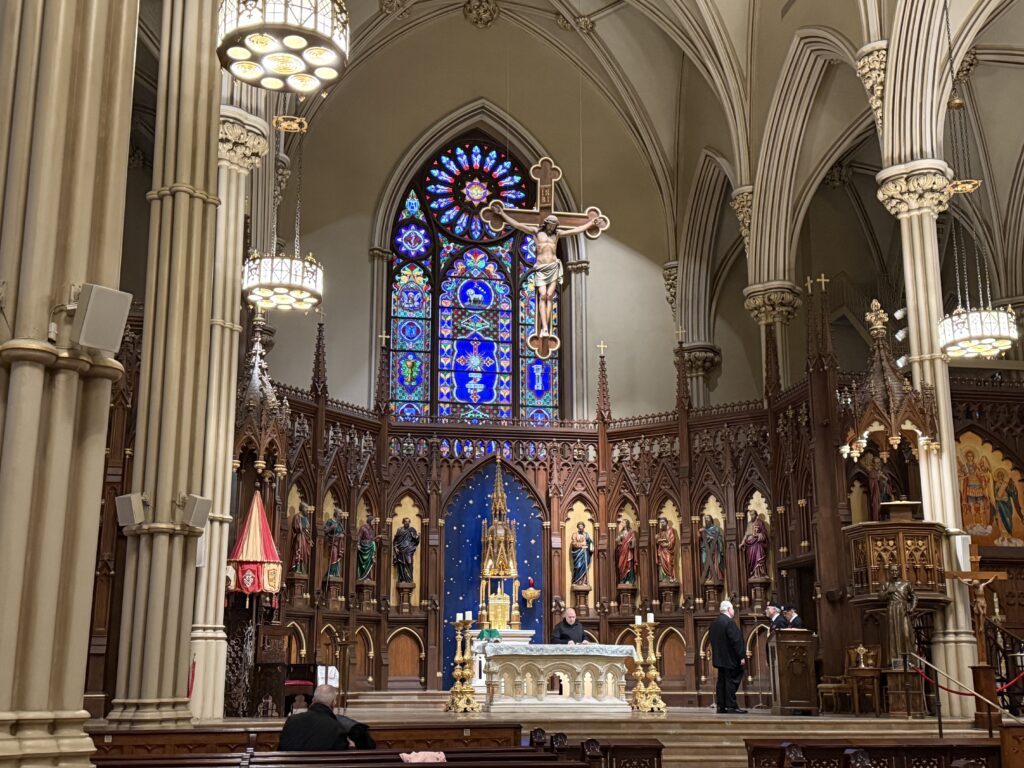
A History of the Basilica of St. Patrick's Old Cathedral in Lower Manhattan
By: Armando Machado
In 1815, Saint Patrick’s Cathedral on Mott Street officially opened

In recognition of the Archdiocese of New York’s 175th anniversary of its elevation from diocese, Richard McCann, official historian of the Basilica of St. Patrick’s Old Cathedral in Lower Manhattan, offered a few words of reflection while noting some highlights from over the decades related to “Old St. Pat’s.”
“The old cathedral on Mott Street was the first cathedral church of the Diocese of New York. The diocese was first established in 1808. The elevation of New York to an archdiocese was a reflection of the growth and importance of New York City at the time because of the major influx of the immigrant population, principally poor Irish families,” McCann told The Good Newsroom during a phone interview.
“And with Bishop John Hughes as the religious leader of the diocese, it was an acknowledgment of the success of Hughes, having led this diocese through very turbulent times; he was a fighter for them, for the Catholic Church itself, and for everything associated with it. His becoming an archbishop was an acknowledgment on the part of Rome of Hughes’ success and impact on the American Catholic Church.”
McCann also noted the prominence of Venerable Pierre Toussaint as a benefactor of Old St. Pat’s. But he added that “unfortunately, the old cathedral was the focal point of a lot of anti-Catholic sentiment.”
The historian noted that in 1815, St. Patrick’s Cathedral on Mott Street officially opened. And in 1879, the new St. Patrick’s Cathedral opened further north on Fifth Avenue — and St. Patrick’s Cathedral on Mott Street reverted to a regular parish church.
As part of the commemoration of the archdiocese’s elevation, The Good Newsroom presents a historical chronology of the Basilica of St. Patrick’s Old Cathedral, as provided by Richard McCann:
June 10, 1785: A group of Catholic laymen under the leadership of French Consul General Hector Saint John Crevecoeur officially organized and incorporated the Roman Catholic Church in New York City.
1785: Shortly after the incorporation of the Roman Catholic Church, a plot of land was purchased from Trinity Church and St. Peter’s became the first Roman Catholic Church in New York City, located on Barclay and Church streets. A portion of the land purchased from Trinity is utilized as a cemetery, becoming the first Roman Catholic Cemetery in New York State.
1796: The growth of St. Peter’s Roman Catholic parish required further land purchases for the cemetery, and between 1801 and 1824, multiple additional lots were purchased to facilitate this need.
1808: Pope Pius VII created the Roman Catholic Diocese of New York, and Dominican Father R. Luke Concanen was appointed the first bishop.
1809: Part of the cemetery purchases for St. Peter’s is set aside for the building of the first cathedral church of the New York Diocese, to be named in honor of Ireland’s patron, St. Patrick. Vicar General Father Anthony Kohlmann dedicated the cornerstone of St. Patrick’s Cathedral on June 8, 1809.
1810: Bishop Concanen dies before assuming his episcopal mission in New York, and Jesuit Father Kohlmann functions as vicar general and administrator of the diocese until the appointment and arrival of the second bishop, John Connolly, in 1815.
1815: St. Patrick’s Cathedral on Mott Street officially opens and is considered so far uptown that the few existing Catholic parishes rearrange Mass schedules to facilitate a flow of Massgoers to the new cathedral church.
The early 19th century represents a period of robust growth for the Catholic Church in New York City. St. Patrick’s serves a diverse population, with a growing number of poor Irish Catholic parishioners. Pierre Toussaint, born into slavery on the Island of Saint Domingue (Haiti), is brought to New York by his liberal-minded master and becomes a hair stylist for New York’s wealthy and upper class families. He is a generous financial supporter of both St. Peter’s and later St. Patrick’s.
1826: French Bishop Jean (John) DuBois is appointed the third diocesan bishop of New York. Because he battled issues with trustee-ism and struggled to connect through his homilies, DuBois encountered tremendous resistance on the part of the largely growing Irish population, who were not happy with a Frenchman being their spiritual leader.
1834: The year of major anti-Catholic riots in cities across the United States. The trustees of St. Patrick’s authorize the building of a brick wall around the cemetery and church buildings to defend against attacks by nativists.
1838: John J. Hughes, native of County Tyrone (Northern Ireland), is consecrated a coadjutor bishop to DuBois in St. Patrick’s Cathedral on January 7. As DuBois continues to suffer declining health, Hughes assumes greater control over diocesan affairs, being named apostolic administrator of the diocese in 1839. When DuBois died in 1842, Hughes was named New York’s fourth diocesan bishop. Hughes will enter his episcopal career at a time when anti-Catholic and anti-Irish sentiment were reaching a zenith in places like New York City, and Hughes will respond with toughness and resolve never before demonstrated by the Catholic clergy. He will break the trustee system, instill financial discipline in churches on shaky monetary footing, combat nativism, advocate for the poor, especially the masses of Irish immigrants fleeing the potato famine, and begin to build a Catholic Church infrastructure, including hospitals, savings institutions, schools, and social services. Although controversial, Hughes will refashion the Catholic Church in New York to be responsive to the needs of the immigrant poor and leave an indelible mark on the American Church.
1850: New York was raised to an archdiocesan see, and John Hughes was named its first archbishop by Pope Pius IX.
1864: John McCloskey succeeded Hughes as Archbishop of New York upon the latter’s death. He was named North America’s first member of the College of Cardinals in 1875.
1879: The new St. Patrick’s Cathedral opened on Fifth Avenue. St. Patrick’s Old Cathedral on Mott Street reverts to a regular parish church.
1991: Pierre Toussaint (interred in Old St. Patrick’s) is reinterred in St. Patrick’s Cathedral.
1996: Pope John Paul II names Pierre Toussaint Venerable.
2010: Pope Benedict names Old St. Patrick’s Cathedral on Mott Street a basilica.

